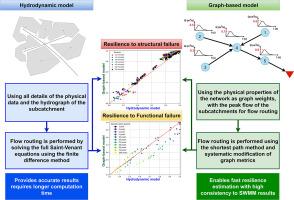城市排水网络的功能和结构弹性评估:一个物理导向的基于图的代理模型
IF 12.4
1区 环境科学与生态学
Q1 ENGINEERING, ENVIRONMENTAL
引用次数: 0
摘要
城市排水网络(udn)的实时管理、优化设计和改造的第一步涉及开发一个能够快速准确评估各种故障情况下的恢复能力的模型。本研究引入了一种新的基于图论的物理指导方法作为弹性评估的替代模型,为传统的水动力模型(如暴雨水管理模型(SWMM))提供了一种计算效率很高的替代方案。考虑到该研究的重点是弹性评估,仅将子流域的最大流量作为物理指导模型的输入,该模型采用了从SWMM输出中导出的非线性方法,以确保与SWMM的弹性计算进行公平比较。基于图的弹性评估结合了加权最短路径法,并引入了改进的水力信息图指标,用于UDN管道的流动路线。这种方法能够比SWMM模型更快地评估结构(即单管故障)和功能故障(即高强度降雨)下的弹性。在两个不同降雨情景下的实际案例研究中,验证了该方法的有效性,表明基于图的恢复力评估与基于SWMM水动力模型的恢复力计算具有很高的一致性。本文章由计算机程序翻译,如有差异,请以英文原文为准。

Functional and structural resilience assessment in urban drainage networks: a physics-guided graph-based surrogate model
The first step in real-time management, optimal design, and retrofitting of urban drainage networks (UDNs) involves developing a model capable of rapidly and accurately assessing resilience under various failure scenarios. This study introduces a novel physics-guided approach based on graph theory as a surrogate model for resilience assessment, offering a computationally highly efficient alternative to traditional hydrodynamic models such as the Storm Water Management Model (SWMM). Given the study's focus on resilience evaluation, only the maximum flow of subcatchments was used as input for the physics-guided model, which employs a nonlinear method derived from SWMM outputs to ensure a fair comparison with SWMM's resilience computations. The graph-based resilience assessment incorporates the weighted shortest path method and introduces modified hydraulically informed graph metrics for flow routing in UDN pipes. This approach enables resilience assessment under structural (i.e., single-pipe failure) and functional failures (i.e., high-intensity rainfalls) significantly faster than the SWMM model. The methodology was validated using two real-world case studies under different rainfall scenarios, demonstrating that the graph-based resilience assessment achieved high consistency with the resilience calculations based on the SWMM hydrodynamic model.
求助全文
通过发布文献求助,成功后即可免费获取论文全文。
去求助
来源期刊

Water Research
环境科学-工程:环境
CiteScore
20.80
自引率
9.40%
发文量
1307
审稿时长
38 days
期刊介绍:
Water Research, along with its open access companion journal Water Research X, serves as a platform for publishing original research papers covering various aspects of the science and technology related to the anthropogenic water cycle, water quality, and its management worldwide. The audience targeted by the journal comprises biologists, chemical engineers, chemists, civil engineers, environmental engineers, limnologists, and microbiologists. The scope of the journal include:
•Treatment processes for water and wastewaters (municipal, agricultural, industrial, and on-site treatment), including resource recovery and residuals management;
•Urban hydrology including sewer systems, stormwater management, and green infrastructure;
•Drinking water treatment and distribution;
•Potable and non-potable water reuse;
•Sanitation, public health, and risk assessment;
•Anaerobic digestion, solid and hazardous waste management, including source characterization and the effects and control of leachates and gaseous emissions;
•Contaminants (chemical, microbial, anthropogenic particles such as nanoparticles or microplastics) and related water quality sensing, monitoring, fate, and assessment;
•Anthropogenic impacts on inland, tidal, coastal and urban waters, focusing on surface and ground waters, and point and non-point sources of pollution;
•Environmental restoration, linked to surface water, groundwater and groundwater remediation;
•Analysis of the interfaces between sediments and water, and between water and atmosphere, focusing specifically on anthropogenic impacts;
•Mathematical modelling, systems analysis, machine learning, and beneficial use of big data related to the anthropogenic water cycle;
•Socio-economic, policy, and regulations studies.
 求助内容:
求助内容: 应助结果提醒方式:
应助结果提醒方式:


